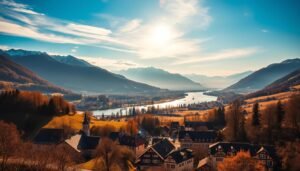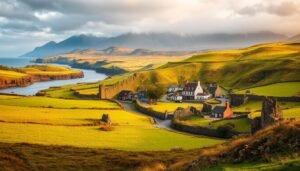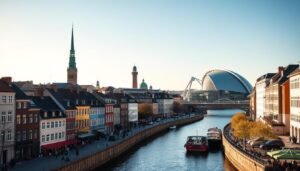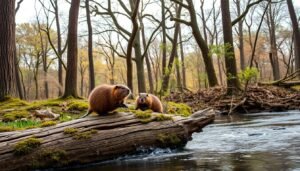Surprising fact: more than half of visitors say Old Quebec feels like stepping into Europe, even though it’s on the St. Lawrence River.
I return here every season because the mix of fortified walls, Château Frontenac on Dufferin Terrace, and cobblestone streets always feels fresh. I’ve built a top list that blends historic sights with quick nature escapes.
Expect easy day trips from my plan: Montmorency Falls thrills, Île d’Orléans tastings, and canyon bridges that beat the crowds. I also show where the funicular links Upper and Lower Town and which vantage points give the best St. Lawrence views.
I write from personal experience and pack the guide with practical tips on timing, transport, and where I book when I want convenience. Use this short plan as a ready-made route or mix sections for your ideal trip.
Key Takeaways
- Old Quebec offers a UNESCO-listed core with strong European charm.
- My plan mixes landmarks and nature for a smooth, scenic trip.
- Montmorency Falls and Île d’Orléans make great day escapes.
- I include practical tips on timing, routes, and where I stay.
- Follow the guide as written or adapt spots to match your pace.
Why I Love Quebec City: A Quick Overview of History, River Views, and European Charm

Walking along the ramparts, I feel the weight of centuries and the river’s steady voice below the bluff. Founded in 1608 by Samuel de Champlain, Quebec City sits on the St. Lawrence River and ranks among the oldest European settlements in North America.
The walled Old Quarter is unique: its fortifications are the only intact city walls north of Mexico and the area is a UNESCO World Heritage Site. That visible history—gates, ramparts, and stone churches—shows more than four hundred years of life.
I love how modern cafés and lively festivals share space with ancient streets. The bluff over the St. Lawrence creates dramatic viewpoints that make sunset walks unforgettable. Heritage here feels lived, not staged; language, food, and daily rituals keep the past alive in the heart of the place.
| Feature | Why it matters | How I enjoy it |
|---|---|---|
| Fortifications | Only intact walls north of Mexico | Walk the ramparts at dawn |
| St. Lawrence River | Frames riverside promenades and views | Sunset strolls along the bluff |
| Living heritage | Language, food, festivals preserve memory | Café stops and seasonal markets |
Trip Essentials at a Glance: When to go, how long to stay, and what I pack

I plan trips around weather windows and festival calendars because timing shapes the whole visit. Summer averages near the mid‑70s F (25°C) with long days and festivals, but prices and lines climb. Winter can be magical — and brutally cold; I’ve felt wind chills near −45°F on a Christmas visit.
My rule: aim for shoulder seasons. Spring maple syrup and fall foliage give milder weather, fewer crowds, and better value.
- For a weekend, I focus on Old Quebec highlights, Dufferin Terrace, Petit‑Champlain, and one day trip.
- In summer I book early; in winter I pack layers, a down jacket, microspikes, and hand warmers.
- I park outside the walls, then walk or use buses with cheap day passes for stress‑free days.
I always carry a compact umbrella, scarf, daypack, reusable bottle, and lightweight gloves. Make sure my phone has a small French phrase list. Plan your quebec city time around seasons you like — that one choice changes how you experience the places here all year.
Best Time to Visit for Fewer Crowds and Maximum Fun

I pick travel dates around what I want to feel—festivals, foliage, or quiet streets—and that choice sets the tone for every moment.best-time-to-visit-amsterdam
Summer, winter, and the magic of shoulder seasons
Summer brings long days, patio dining, and packed festival calendars. I budget more for hotels and reserve ahead.
Winter glows with holiday lights, the Winter Carnival, Hôtel de Glace (Jan–Mar), Nordic spas, and skiing at Mont‑Sainte‑Anne. I plan indoor museum days during cold snaps.
What each season means for events, prices, and outdoor activities
- Spring: maple syrup tastings and Montmorency Falls at peak flow.
- Fall: vivid foliage on Île d’Orléans and hikes at Parc national des Grands‑Jardins.
- Shoulder seasons: milder weather, lower prices, easier reservations.
- For a quick weekend, I pick terraces and river walks in warm months or spas and cozy bistros in winter.
| Season | Main draws | Planning tip |
|---|---|---|
| Spring | Maple tastings, roaring falls | Book one tasting day; expect wet trails |
| Summer | Festivals, long daylight | Reserve hotels and restaurants early |
| Fall | Foliage, harvests | Drive scenic routes; pack layers |
| Winter | Carnival, ice hotel, Nordic spas | Plan indoor options for cold days |
For a full planning checklist, see my seasons and best time to visit Quebec. My top tip: choose one signature seasonal activity and build your days around it for the best year of memories.
Getting Around: Walking, funiculars, buses, and the best way to see the city

I prefer moving slowly through lanes and plazas; that pace reveals tiny doorways and quiet courtyards you miss when rushing.
I mostly choose walking for short hops inside the walls. Many major sights sit within a few minutes of each other, so I group walks by upper (terrace, gates) and lower town (Petit‑Champlain, port).
The Funicular links Dufferin Terrace with Rue du Petit‑Champlain and saves knees on the climb. Reported fares are about $3.75 one way, and I map its stations before I leave.
Buses work great when I roam beyond the walls. I buy a day pass for quick hops, avoid parking headaches, and pivot between stops without stress.
- I park outside the fortifications, then switch to walking for calm exploring.
- I keep to the shady side on hot afternoons and plan stair routes carefully.
- When mobility matters, I pair the Funicular with level riverfront paths.
| Option | Why I pick it | Best use |
|---|---|---|
| Walk | Free, immersive | Historic core, short routes |
| Funicular | Saves legs, scenic | Upper ⇄ Lower Town |
| Bus | Cheap day passes | Trips beyond the walls |
My Perfect Old Quebec Walking Route through Cobblestone Streets

I begin my walk where the town’s story was inscribed in stone, and that start shapes every step. This short loop fits under two hours and shows why I return for layered charm and simple discoveries.
Place Royale and the story of New France
I start at Place Royale. Restored stone buildings and a bust of Louis XIV mark the founding site from 1608. This is grounding: the square connects you with the earliest urban fabric of the town.best-places-to-visit-in-april
Notre-Dame-des-Victoires and a North America gem
I step inside Notre‑Dame‑des‑Victoires when it is open. Built in 1688, this is one of the oldest stone churches in North America and a quiet highlight of local history.
Rue du Trésor, frescoes, and hidden courtyards I never skip
Next I weave along Rue du Trésor for local art and then detour to the Fresque des Québécois and Fresque du Petit‑Champlain. I pause in the Séminaire de Québec courtyard to read the sundial and enjoy a calm moment away from busy streets.
- I keep my eyes up for gables, dormers, and layered façades of the buildings.
- Wear grippy soles—smooth cobblestone rewards careful steps.
- Plan morning light or late afternoon for the best photos and softer shadows.
“Slow walking reveals details you miss on a fast route.”
I finish with a café stop in the square and linger over the sense of place before I wander back along a narrow street.
Château Frontenac and Terrasse Dufferin: Iconic views over the St. Lawrence River
![]()
I always feel a nudge to pause at the terrace when the skyline and water meet in one frame. The Château Frontenac opened in 1893 and rises 18 floors, crowning Dufferin Terrace with sweeping panoramas over the lawrence river.
My favorite photo spots include Place d’Armes, the playful City Center Swing, and stretches along the boardwalk. Each spot gives a different way to frame the hotel, its copper roofs, and nearby buildings.
Beneath the terrace lies the Saint‑Louis Forts and Châteaux archaeological site with artifacts dating from 1620–1834. That layer of history reminds me how this place has evolved across the years.
How I shoot it
- I loop around the façade for close details, then step back on the boardwalk for wider views.
- Early morning or golden hour cleans up crowds and softens light for better shots.
- From Petit‑Champlain I add the funicular track for a unique foreground spot.
“The hotel’s silhouette anchors the riverfront and the stories held here.”
| Vantage | Best for | Why I pick it |
|---|---|---|
| Place d’Armes | Classic skyline | Direct angle of the hotel and plaza life |
| Boardwalk | Wide river views | Panoramic frames with St. Lawrence backdrop |
| Petit‑Champlain | Context shots | Funicular track and narrow streets add depth |
| Dufferin Terrace | Detail & panorama | Mix of architectural closeups and distant river views |
Fortifications and La Citadelle: Walking the only walled city in North America
![]()
I begin at Porte St‑Jean and feel how the ramparts once shaped daily life in this town. The walls, with Kent Gate and St‑Louis Gate, are the last intact city walls north of Mexico in north america.
Walking the ramparts gives broad river views and a clear sense of the old footprint. I trace how the defenses protected strategic approaches and imagine life across the years.best-time-to-visit-belize
La Citadelle (built 1820–1850) remains an active military base. In summer I time my visit for the 10 am changing of the guard and hope to spot the regiment’s royal goat, Batisse. Guided tours help decode the star‑shaped fort, barracks, and military history.
“The walls turn maps into lived memory; every gate frames a different story.”
I link this walk to the Plains of Abraham to mark the 1759 shift in the place’s fate. Ending near Parliament or the terrace makes for an easy loop back to cafés and rest stops.
| Feature | Why it matters | Best time |
|---|---|---|
| Ramparts | Reveal original town footprint | Morning for light and calm |
| Gates | Unique photo angles (St‑Jean, St‑Louis, Kent) | Any daylight hour |
| La Citadelle | Active base with living history | Summer, 10 am guard ceremony |
Ride the Old Quebec Funicular, then Wander Petit-Champlain

A short glide down the funicular feels like stepping into a cozier world beneath the terrace. The funicular (est. 1879; about $3.75 one way) links Dufferin Terrace with Rue du Petit‑Champlain and saves my legs for exploring narrow lanes.things-to-do-in-charleston-sc
I meander along pedestrian streets lined with boutiques, maple shops, and small galleries. Umbrella Alley (Rue du Cul‑de‑Sac) is a quick, colorful photo stop best early for softer light and fewer people.
Then I climb the Breakneck Steps (Escalier Casse‑Cou), the oldest staircase dating from the 1600s. The rise gives a classic view back toward the hotel and terrace and links the lower place with the ramparts.
- My loop: start at Dufferin Terrace, ride down via funicular, browse cobblestone lanes, return by stairs.
- I peek at the Royal Battery for river views that echo the old defenses.
- For lunch I pick a bistro near the main street and leave room for slow browsing in tiny shops.
“This compact quarter is my favorite spot to savor the lower town’s charm.”
Museums and Culture I Recommend When the Weather Turns

Museums and sacred spaces offer a warm, focused way to learn how this place layered its past across the years.
Musée de la Civilisation is my go‑to on rainy or frigid days. Rotating exhibits are modern and engaging, and artifacts found onsite sit proudly in the atrium.
I add a guided tour when I can; it ties objects to people and moments and makes a whole afternoon feel cohesive.
Under Dufferin Terrace, the Saint‑Louis Forts and Châteaux site reveals 17th–19th‑century remains. Walking those foundations connects visible streets with buried governance and trade.
I always step into Notre‑Dame de Québec Basilica‑Cathedral for its stained glass, sculptures, and quiet chapels. The Séminaire de Québec courtyard then serves as a peaceful architectural interlude.
- I plan one major indoor place per day so energy stays high.
- I check exhibit calendars and book timed entries for limited shows.
- Audio guides and a nearby café help me reflect and map my next move.
“Culture days balance outdoor walks and let the city’s stories settle.”
| Spot | Focus | Best for |
|---|---|---|
| Musée de la Civilisation | Modern exhibits; local culture | Rainy or cold afternoons |
| Saint‑Louis Forts and Châteaux | Archaeology; 17th–19th century remains | Short tours under the terrace |
| Notre‑Dame Basilica‑Cathedral | Historic sacred art and chapels | Quiet reflection and photography |
| Séminaire de Québec courtyard | Calm architecture | Between museum stops |
Where I Eat: Classic restaurants, local game, and riverside views
Food shapes my days more than weather; I chase flaky pastries and riverfront suppers. Meals here range from quick café stops to leisurely dinners that stretch into the night.things-to-do-in-san-diego
Old favorites for breakfast, lunch, and dinner
For breakfast I rotate between Paillard’s pastries and Smith Café’s smooth coffee. Both start my morning with warm bread and strong espresso.
At lunch I linger in Petit‑Champlain at L’Escale Bistro et Crêperie or grab a sandwich at Chez Bourlay Counter for a picnic. Afternoon tea at Place Dufferin inside the Château Frontenac feels delightfully classic.
For dinner I often pick Aux Anciens Canadiens for tourtière and local comfort plates. Le Lapin Sauté is where I order rabbit; it’s rich and memorable.
What to try and practical tips
- My musts: tourtière, rabbit, maple‑glazed sweets, and seafood at Chez Rioux & Pettigrew.
- I love Maison Livernois for cocktails and a relaxed night vibe, and Le Sam when I want a river view.
- Save room for Dolce Gelato or COWS after dinner.
- I book popular restaurants on weekends and in summer; ask servers about seasonal game and maple specials.
“A good meal here mixes history, local ingredients, and a view.”
| Meal | Spot | Why I pick it |
|---|---|---|
| Breakfast | Paillard / Smith Café | Pastries and strong coffee |
| Lunch | L’Escale / Chez Bourlay | Scenic Petit‑Champlain or picnic‑friendly |
| Dinner | Aux Anciens Canadiens / Le Lapin Sauté | Traditional fare, game, rabbit |
Cafés, Bakeries, and Sweet Stops I Can’t Resist
My favorite cafés double as observation posts where street life and slow mornings meet.
I gravitate to Café La Maison Smith for buttery pastries and prime people‑watching near Place Royale and the hotel square. Paillard’s baguette sandwiches are my quick, delicious refuel between visits.
For dessert I pick Chocolato on Rue Saint‑Jean or COWS for an indulgent scoop. I browse chocolate and maple shops on the walk back; small boutique stores line the route and make browsing fun.
Cozy rooms in cafés make rainy afternoons feel like time well spent. Window seats give me a front‑row view of street life and serve as planning hubs where I map the rest of my day.things-to-do-in-nyc
I always bring a small box of treats home to my hotel for a late snack. When I want more ideas, I check a local list of cafés in Quebec City and pick the next stop.
| Spot | Why I like it | Ideal time |
|---|---|---|
| Café La Maison Smith | People‑watching, flaky pastries | Morning |
| Paillard | Baguettes, sandwiches | Midday |
| Chocolato / COWS | Chocolate and ice cream treats | Afternoon |
| Rue Saint‑Jean shops | Boutique browsing and maple finds | Between sights |
“A good café stop is a tiny pause that changes the whole day.”
Day Trips That Elevate Any Quebec City Itinerary
If you have a spare day, I pick one major natural stop and one tasting or market for balance. That combo keeps energy high and gives a sense of the wider region without long drives.
Montmorency Falls: Cable car, suspension views, and winter ice
Montmorency Falls sits about 30 minutes from the center and delivers big‑water drama close to town. I usually ride the cable car up for sweeping views, then return on the stair route for lookout platforms and close shots.
Options include a zipline in summer and several walking paths. In winter the falls freeze into a luminous sugarloaf that feels otherworldly and worth the short trip.
Île d’Orléans: Tasting rooms, farm stands, and winery patios
I treat Île d’Orléans as a relaxed afternoon of samplings. Cassis Monna & Filles and farm stands make easy stops for jam, cider, and fresh produce.
I often book a half‑day tour when I want no drive and the guide’s local tips. Otherwise, I hop between tasting rooms and a winery patio at my own pace.
Canyon Sainte‑Anne: Bridges, roaring water, and fewer crowds
Canyon Sainte‑Anne feels intimate and adventurous. Three suspension bridges and cliff viewpoints create photo ops without the bigger crowds at the falls.
I budget a couple of unrushed hours for the canyon loop, then head back with a short list of favorite views. When time is tight, I pick one waterfall stop and one tasting stop to balance the trip.
“Pick one big natural stop and one local tasting for the easiest, most rewarding day outside the walls.”
| Spot | Distance / Time | Main draws | Best plan |
|---|---|---|---|
| Montmorency Falls | ~30 minutes | Cable car, stairs, zipline, winter ice | Half‑day; ride cable car, walk lookouts |
| Île d’Orléans | 20–35 minutes | Tastings (Cassis Monna & Filles), farm stands, wineries | Half‑day; tasting stops or guided tour |
| Canyon Sainte‑Anne | 35–45 minutes | Three suspension bridges, cliff views, fewer crowds | Couple of hours; loop trails and photo stops |
Outdoor Adventures Near the City: Rivers, ridgelines, and roaring colors
A half hour drive opens forested valleys, steep summits, and paddling routes that feel a world away. I use short escapes as a natural counterpoint to historic streets.
Parc National de la Jacques‑Cartier
About 30 minutes from the center, this river‑carved valley offers roadside viewpoints, canoe launches, and trails that range from brisk to serious.
My plan is a day here: scenic drives, a hike like Les Loups if I want a challenge, or Éperon for a shorter loop.
Parc national des Grands‑Jardins
Late September is the highlight; bright yellow forests make for classic fall photography.
I climb La Chouenne for quick, windswept views and always book park access ahead—authorization limits visits some years.things-to-do-in-portland-oregon
Mont‑Sainte‑Anne
For steep workouts and biking, this is my top pick. Trails such as La Crête and La Gondoleuse push legs, while Chutes Larose offers waterfall photo stops.
I check gondola operations; if it’s closed, I hike up and ride most of the way down. Summer brings paddling windows and longer trail hours, so I pack water and sun protection.
“Mix a morning hike with a late lunch back in Old Quebec for the best balance.”
| Spot | Main draw | Best plan |
|---|---|---|
| Jacques‑Cartier | Valley, canoeing | Half‑day or full‑day hike |
| Grands‑Jardins | Peak foliage | Late‑Sept summit short walk |
| Mont‑Sainte‑Anne | Biking, waterfalls | Steep hikes or gondola ride |
Winter in Quebec City: Lights, spa steam, and snowy streets
Winter here feels like a carefully staged scene—bright lights, hushed lanes, and a pulse of outdoor fun that keeps me moving.
Hôtel de Glace: Ice bars, sculptures, and day visits
Hôtel de Glace operates each year from January through March. I plan a day visit to admire carved rooms, detailed ice art, and the ice bar without an overnight stay. Day tickets let me wander the sculpted suites, sip a drink from an ice glass, and leave for a warm dinner that night.
Nordic spa circuits: Hot-cold-relax the right way
I follow the classic Nordic sequence—heat (sauna or steam), cold plunge, then rest. I repeat three rounds for the full effect and feel the stress melt away.
- I book spa time ahead on busy weekends and pair the visit with a cozy dinner.
- Winter tours often bundle transport, tickets, and timing on frigid days.
- I choose lodging close to the old town core so I can pop home to warm up between outings.
Snowy streets transform familiar views, so I build extra time for slower walks and photo stops. I pack traction for icy sidewalks and a thermos for hot chocolate on the go. Even on a cold night, a short terrace view feels brief but memorable.things-to-do-in-kauai
“With smart layers and patient pacing, winter becomes one of the city’s most magical seasons.”
| Highlight | Why it matters | Practical tip |
|---|---|---|
| Hôtel de Glace | Ice art, themed suites, ice bar | Day tickets available; dress warmly for outdoor exhibits |
| Nordic spas | Heat-cold-rest circuits restore circulation | Repeat three rounds; reserve weekend slots |
| Winter Carnival & lights | Festive nights and glowing streets | Book tours for bundled transport and timing |
Where I Stay: From boutique hotels in Old Quebec to nature-side retreats
Choosing where I rest shapes the pace of every day. I often pick a room that matches my plans: historic streets for easy walks or a mountainside base for early trailheads.
Chic and historic stays inside the walls
I splurge at Château Frontenac when I want unmatched location and heritage. For modern boutique vibes, Monsieur Jean delivers chic decor and comfy rooms.
Hotel Manoir Morgan gives great value steps from top sights. Le Monastère des Augustines offers wellness in a quiet monastery, and Auberge Saint‑Antoine blends artifacts with refined comfort.
Mountain and riverside bases for active days
When I plan hikes or skiing, I book Delta Hotels Mont‑Sainte‑Anne for trail access. Club Med Québec‑Charlevoix works well for families who want an all‑in stay near slopes.
I match my hotel to my itinerary: inside the walls for walkable nights, mountainside for early starts. I always request rooms with views and book early for the best boutique picks.
“Pick lodging that fits your days, and every night will feel like a reward.”
| Base | Best for | Why I pick it |
|---|---|---|
| Château Frontenac | Iconic luxury | Central, historic, sunrise views |
| Monsieur Jean / Manoir Morgan | Boutique comfort | Stylish rooms, steps from sights |
| Le Monastère / Auberge St‑Antoine | Wellness & culture | Quiet, restorative, museum touches |
| Delta Mont‑Sainte‑Anne / Club Med | Active escapes | Trail and ski access, family amenities |
For more on areas and where I book, see my best areas to stay.
Best things to do in Quebec City
I favor a route that mixes terrace views, narrow lanes, and one nature escape. My short list starts with Dufferin Terrace and Château Frontenac for river panoramas that stick in my memory.
I pair Place Royale with Notre‑Dame‑des‑Victoires for a walk through living history. Then I wander Petit‑Champlain, pause under Umbrella Alley, and let the lower town streets reveal small shops and cafés.
I ride the funicular one way and take the Breakneck Steps the other for variety. Walking the fortifications toward La Citadelle gives me broad views, and I often unwind on the Plains of Abraham afterward.
For a culture day, I pick the Musée de la Civilisation and a landmark church. Rue Saint‑Jean is my dining corridor; I stop for pastries, bistro lunches, and a slow evening meal near an old square.
For one nature stop, I choose either Montmorency Falls or Canyon Sainte‑Anne, then add a park hike at Parc de la Jacques‑Cartier or a trail at Mont‑Sainte‑Anne. A Nordic spa resets my legs mid‑trip, and in winter I add a daytime visit to Hôtel de Glace.things-to-do-in-japan
- Balance: terrace + lanes + one nature escape.
- Variety: funicular ride, fort walls, museum, and Rue Saint‑Jean food.
- Seasonal pick: Montmorency or Sainte‑Anne; Hôtel de Glace for winter.
“This list keeps my days balanced between must‑sees and relaxed wandering.”
Conclusion
This compact, walkable old town rewards slow pacing and a flexible plan that welcomes surprises. I leave each visit already sketching a fresh route and thinking about the river view I’ll chase next in quebec city.
Make sure you balance big landmarks with lazy hours in squares. The best way is on foot, with occasional funicular rides and a bus hop when you want a quick stretch beyond the walls.
I tailor every trip to the season and keep one small part of my day open for serendipity. For a final refresher, review my Old Quebec highlights before you head home; the whole experience will echo long after you leave quebec city.





















